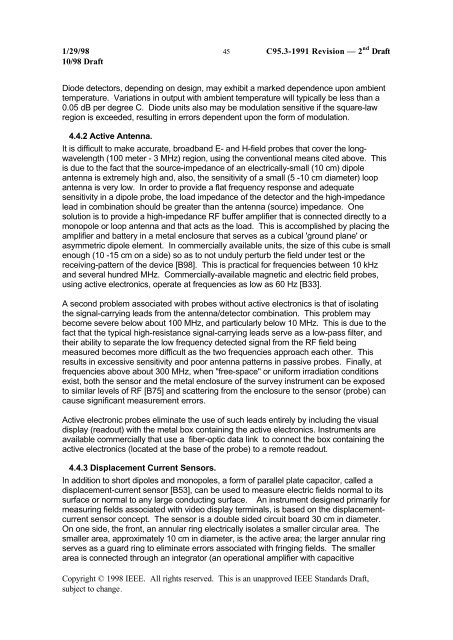DRAFT Recommended Practice for Measurements and ...
DRAFT Recommended Practice for Measurements and ...
DRAFT Recommended Practice for Measurements and ...
You also want an ePaper? Increase the reach of your titles
YUMPU automatically turns print PDFs into web optimized ePapers that Google loves.
1/29/98 45 C95.3-1991 Revision — 2 nd Draft<br />
10/98 Draft<br />
Diode detectors, depending on design, may exhibit a marked dependence upon ambient<br />
temperature. Variations in output with ambient temperature will typically be less than a<br />
0.05 dB per degree C. Diode units also may be modulation sensitive if the square-law<br />
region is exceeded, resulting in errors dependent upon the <strong>for</strong>m of modulation.<br />
4.4.2 Active Antenna.<br />
It is difficult to make accurate, broadb<strong>and</strong> E- <strong>and</strong> H-field probes that cover the longwavelength<br />
(100 meter - 3 MHz) region, using the conventional means cited above. This<br />
is due to the fact that the source-impedance of an electrically-small (10 cm) dipole<br />
antenna is extremely high <strong>and</strong>, also, the sensitivity of a small (5 -10 cm diameter) loop<br />
antenna is very low. In order to provide a flat frequency response <strong>and</strong> adequate<br />
sensitivity in a dipole probe, the load impedance of the detector <strong>and</strong> the high-impedance<br />
lead in combination should be greater than the antenna (source) impedance. One<br />
solution is to provide a high-impedance RF buffer amplifier that is connected directly to a<br />
monopole or loop antenna <strong>and</strong> that acts as the load. This is accomplished by placing the<br />
amplifier <strong>and</strong> battery in a metal enclosure that serves as a cubical 'ground plane' or<br />
asymmetric dipole element. In commercially available units, the size of this cube is small<br />
enough (10 -15 cm on a side) so as to not unduly perturb the field under test or the<br />
receiving-pattern of the device [B98]. This is practical <strong>for</strong> frequencies between 10 kHz<br />
<strong>and</strong> several hundred MHz. Commercially-available magnetic <strong>and</strong> electric field probes,<br />
using active electronics, operate at frequencies as low as 60 Hz [B33].<br />
A second problem associated with probes without active electronics is that of isolating<br />
the signal-carrying leads from the antenna/detector combination. This problem may<br />
become severe below about 100 MHz, <strong>and</strong> particularly below 10 MHz. This is due to the<br />
fact that the typical high-resistance signal-carrying leads serve as a low-pass filter, <strong>and</strong><br />
their ability to separate the low frequency detected signal from the RF field being<br />
measured becomes more difficult as the two frequencies approach each other. This<br />
results in excessive sensitivity <strong>and</strong> poor antenna patterns in passive probes. Finally, at<br />
frequencies above about 300 MHz, when ''free-space'' or uni<strong>for</strong>m irradiation conditions<br />
exist, both the sensor <strong>and</strong> the metal enclosure of the survey instrument can be exposed<br />
to similar levels of RF [B75] <strong>and</strong> scattering from the enclosure to the sensor (probe) can<br />
cause significant measurement errors.<br />
Active electronic probes eliminate the use of such leads entirely by including the visual<br />
display (readout) with the metal box containing the active electronics. Instruments are<br />
available commercially that use a fiber-optic data link to connect the box containing the<br />
active electronics (located at the base of the probe) to a remote readout.<br />
4.4.3 Displacement Current Sensors.<br />
In addition to short dipoles <strong>and</strong> monopoles, a <strong>for</strong>m of parallel plate capacitor, called a<br />
displacement-current sensor [B53], can be used to measure electric fields normal to its<br />
surface or normal to any large conducting surface. An instrument designed primarily <strong>for</strong><br />
measuring fields associated with video display terminals, is based on the displacementcurrent<br />
sensor concept. The sensor is a double sided circuit board 30 cm in diameter.<br />
On one side, the front, an annular ring electrically isolates a smaller circular area. The<br />
smaller area, approximately 10 cm in diameter, is the active area; the larger annular ring<br />
serves as a guard ring to eliminate errors associated with fringing fields. The smaller<br />
area is connected through an integrator (an operational amplifier with capacitive<br />
Copyright © 1998 IEEE. All rights reserved. This is an unapproved IEEE St<strong>and</strong>ards Draft,<br />
subject to change.
















